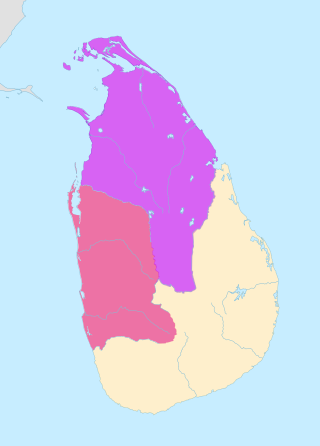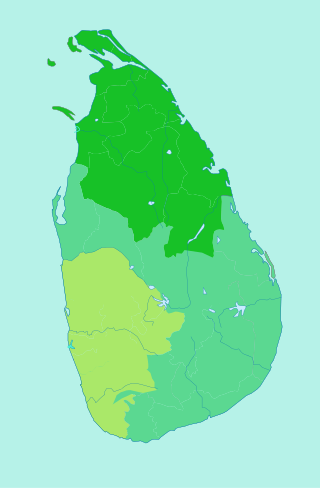Related Research Articles

Poḷonnaruwa, also referred as Pulathisipura and Vijayarajapura in ancient times, is the main town of Polonnaruwa District in North Central Province, Sri Lanka. The modern town of Polonnaruwa is also known as New Town, and the other part of Polonnaruwa remains as the royal ancient city of the Kingdom of Polonnaruwa.

Parākramabāhu I, or King Vijay the great, was the king of Polonnaruwa from 1153 to 1186. He oversaw the expansion and beautification of his capital, constructed extensive irrigation systems, reorganised the country's army, reformed Buddhist practices, encouraged the arts and undertook military campaigns in South India and Burma. The adage "Not even a drop of water that comes from the rain must flow into the ocean without being made useful to man" is one of his most famous utterances.

The Kingdom of Polonnaruwa was the Sinhalese kingdom that expanded across the island of Sri Lanka and several overseas territories, from 1070 until 1232. The kingdom started expanding its overseas authority during the reign of Parakramabahu the Great.
Vikramabahu was a medieval king of Sri Lanka. Following the death of his father in 1029, Vikramabahu led the resistance movement against the Chola invaders of the country, ruling from the southern principality of Ruhuna. He spent a number of years building up his forces to drive out the Chola, but died before he could launch his military campaign.
Kitti Sri Megha, also referred to as Kittisrimegha, was a medieval king of the principality of Dakkinadesa in Sri Lanka. The nephew of King Vijayabahu I, he attempted to seize the throne of Sri Lanka along with his two brothers in 1110 CE, but was defeated by Vickramabahu I. He then retreated to the south of the country, which he initially ruled with his younger brother Sri Vallabha. He later ascended to the throne of Dakkinadesa following the death of his older brother Manabharana.

Vijayabahu I, also known as Vijayabahu the Great, was a medieval king of Sri Lanka. Born to a royal bloodline, Vijayabahu grew up under Chola occupation. He assumed rulership of the Ruhuna principality in the southern parts of the country in 1055. Following a seventeen-year-long campaign, he successfully drove the Cholas out of the island in 1070, reuniting the country for the first time in over a century. During his reign, he re-established Buddhism in Sri Lanka and repaired much of the damage caused to infrastructure during the wars. He offered the Thihoshin Pagoda(Lord of Sri Lanka Buddha image) to Burma king Alaungsithu and it is now still in Pakokku.

The Kingdom of Dambadeniya was a medieval kingdom in what is present-day Sri Lanka. The kingdom's rulers reigned from 1220–1345.

The Maya Rata (Principality of), also known as the Kingdom of Dakkinadesa, was a principality or an administrative region of the Sinhalese kingdom. It was located in the Southwestern part of Sri Lanka, bordered the Deduru Oya. Its last capital was Parakramapura. The principality was disbanded following the formation of the second kingdom of Polonnaruwa by Parakramabahu I.
Parakrama Pandyan II, also Pandu Parakramabahu of Polonnaruwa or Parakrama Pandu, was a Pandyan king who invaded the Kingdom of Polonnaruwa in the thirteenth century and ruled from 1212 to 1215 CE. His namesake royal Parakrama Pandyan I had ruled in Madurai fifty years earlier and had sought help from his contemporary Parakramabahu I of Polonnaruwa when faced with a Pandyan civil war. Parakrama Pandyan II came to the throne deposing Lilavati—ruling monarch, consort and successor of Parakramabahu I—as king of Polonnaruwa. He ruled for three years until Polonnaruwa was invaded and he was taken captive by Kalinga Magha, who succeeded him.
Vikramabahu II was King of Polonnaruwa in the twelfth century, who ruled in 1196, for three months. He succeeded his nephew Vira Bahu I as king of Polonnaruwa and was murdered and succeeded by another nephew Chodaganga, a son of his sister. He was the younger brother of Nissanka Malla.
Chodaganga was King of Polonnaruwa in the twelfth century, who ruled from 1196 to 1197. He succeeded his uncle Vikramabahu II, whom he usurped as king of Polonnaruwa and ruled for nine months before he was deposed and deprived of his eyes by the General Senevirat who installed Lilavati, wife of Parakramabahu I. Chodaganga was also a nephew of Nissanka Malla.

Sahassa Malla was King of Polonnaruwa in the thirteenth century. He ruled the Kingdom of Polonnaruwa from 1200 to 1202. He succeeded Lilavati, who was removed from the throne by her co-ministers. He was deposed by General Ayasmantha and succeeded by Kalyanavati. He was the younger brother of Nissanka Malla.
Kalyanavati was Queen of Polonnaruwa from 1202 to 1208. She was one of the few queens that reigned in Sri Lanka. She succeeded Sahassa Malla as Queen of Polonnaruwa and was succeeded by Dharmasoka.
Anikanga was King of Polonnaruwa in the thirteenth century, who ruled from 1209 to 1209. He succeeded his son Dharmasoka, who was installed as king of Polonnaruwa, and was succeeded by Queen Lilavati. He reigned for 17 days. He allied with the Cholas and invaded Polonnaruwa to capture the throne.

Bhuvanaikabahu I was King of Dambadeniya in the 13th century, who ruled from 1271 to 1283. He succeeded his brother Vijayabahu IV as King of Dambadeniya and an Interregnum of 19 years is thought to have occurred after his death. His nephew Parakkamabahu III ruled from Polonnaruwa, and was not formally considered as a King of Dambadeniya.
Parakramabahu III was a medieval king of Dambadeniya, from 1302 to 1310. He succeeded his uncle Bhuvanaikabahu I as King of Dambadeniya and was succeeded by Bhuvanaikabahu II.
Dappula II was King of Anuradhapura in the 9th century, whose reign lasted from 807 to 812. He succeeded his father Mahinda II as King of Anuradhapura and was succeeded by his son Mahinda III.

The Polonnaruwa period was a period in the history of Sri Lanka from 1017, after the Chola conquest of Anuradhapura and when the center of administration was moved to Polonnaruwa, to the end of the Kingdom of Polonnaruwa in 1232.

Malay invasions of Sri Lanka occurred in the mid-13th century, when the Malay ruler Chandrabhanu Sridhamaraja of Tambralinga, invaded Sri Lanka twice during the reign of king Parakramabahu II of Dambadeniya. Both invasions were successfully repulsed by the Kingdom of Dambadeniya.
